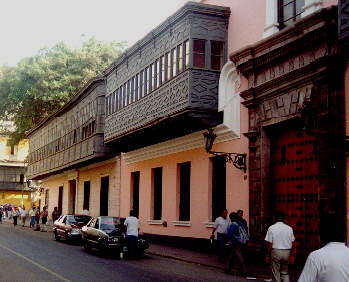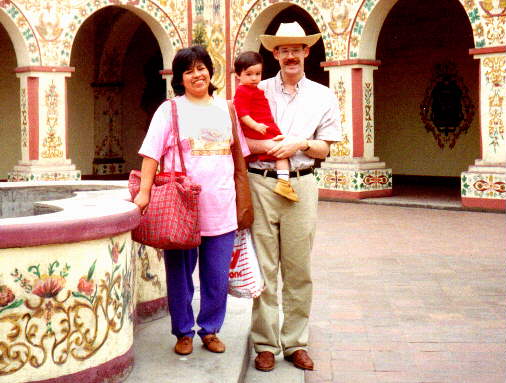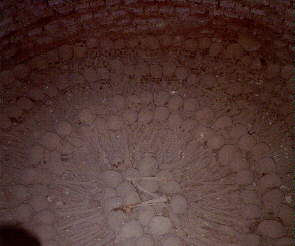
An American in Lima
*
Part I - City of the Kings
Home | Part 2
My in-laws tend to apologize for the condition of Lima. It was never
as dirty, noisy, or just plain awful it is now, they say. At least,
not during the Belaunde administration. And don't worry about the
weather. In January, the fog will lift, and then you'll have an
excellent view of the smog.
The truth is that Lima is a beautiful city with a rich history,
struggling with the runaway growth that has beleaguered most
Latin American capitals. And the fog (garua) did lift,
just in time for my arrival, revealing the City of the Kings
in all its noisy, sooty, and crowded splendor.
I took up residence at my in-laws' house,
"Leoncio Prado, Block #O-1, Lot 4, District Rímac,
Department of Lima, Province of Lima." Rimac itself is just
across the river from the old town -- one time a refuge from the city,
now indistinguishable from the same. Leoncio Prado, a patchwork
of narrow passages surrounded by houses in various stages of
construction was carved out of disused land near the National
Guard compound. A perennial shortage of funds forces most "rimenses"
to occupy unfinished dwellings. Children practice rollerblading
along the alleys until midnight or later. At sundown the boom boxes
are broken out and the streets fill with the sound of salsa and
criollo waltzes:
No me importa que quieras a otro, y a mi me desprecias.
No me importa que solo me dejes, llorando tu amor.
Eres libre de amar en la vida y yo no te culpo,
Si tu alma no supo quererme, como te quise yo.
Solo sé que es en vano pedirte que vuelvas conmigo.
Por que sé que tu siempre has mentido, llorando mi amor.
Y yo en cambio no quiero amargarte, y estorbar tu vida.
Soy sincero y saber perdonarte sin guardar rencor.
No creas que siento despecho al ver que te alejas.
Si me dejas por un nuevo amor, te dejo también.
Si al fin con el tiempo el olvido curará mis penas.
Sigue feliz tu camino y que te vaya bien.
This would carry on until dawn, and, on Christmas and New
Years, there were firecrackers as well. Although I got used to it,
sometimes I longed for some peace and quiet.
The Franciscan monks in Lima probably felt the same way as well.
Back when Rimac was relatively secluded from the main town, they
constructed a retreat and monestary at the foot of the Cerro
San Cristóbal. Because the monks preferred modest
footwear or none at all, they became known as the descalzos
(barefoot), and their convent took on the same name.

The fountain at the Convento de los Descalzos.
We came to Lima in part to have our son baptized at the convent,
where many of his cousins and aunts and uncles had been. During our
visit, I was surprised at how quiet it was, in contrast to the
endless commotion just outside.
 The many churches and
convents in Lima were an important part of the burgeoning spiritual
life of the colonial city. In case you had any doubt about
the way faith pervaded colonial life, note that Lima was originally
called the City of the Kings because it was founded on Epiphany.
A Limeño in colonial times was
baptized, married, and buried by the church.
The many churches and
convents in Lima were an important part of the burgeoning spiritual
life of the colonial city. In case you had any doubt about
the way faith pervaded colonial life, note that Lima was originally
called the City of the Kings because it was founded on Epiphany.
A Limeño in colonial times was
baptized, married, and buried by the church.
This deep well
in the catacombs beneath the city serves not only as a
resting place for the remains of Limeños past, it is also
said to protect the church above from earthquakes. I had never
experienced an earthquake, and I said a prayer to the
Señor de los Temblores in the hope that I never would.
Note: I know perfectly well that the
term "American" is inaccurate in this context. I always thought
that norteamericano was the correct Spanish term
for someone from the United States, but my
wife and all of her family kept referring to me as
el americano, and who am I to correct them?
Home | Part 2
© 1997 David Brantley - Updated 13-Jan-1997


 The many churches and
convents in Lima were an important part of the burgeoning spiritual
life of the colonial city. In case you had any doubt about
the way faith pervaded colonial life, note that Lima was originally
called the City of the Kings because it was founded on Epiphany.
A Limeño in colonial times was
baptized, married, and buried by the church.
The many churches and
convents in Lima were an important part of the burgeoning spiritual
life of the colonial city. In case you had any doubt about
the way faith pervaded colonial life, note that Lima was originally
called the City of the Kings because it was founded on Epiphany.
A Limeño in colonial times was
baptized, married, and buried by the church.